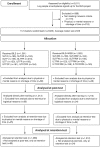Effectiveness of web-based education in addition to basic life support learning activities: A cluster randomised controlled trial
- PMID: 31295275
- PMCID: PMC6622500
- DOI: 10.1371/journal.pone.0219341
Effectiveness of web-based education in addition to basic life support learning activities: A cluster randomised controlled trial
Abstract
Background: Effective education in basic life support (BLS) may improve the early initiation of high-quality cardiopulmonary resuscitation and automated external defibrillation (CPR-AED).
Aim: To compare the learning outcome in terms of practical skills and knowledge of BLS after participating in learning activities related to BLS, with and without web-based education in cardiovascular diseases (CVD).
Methods: Laymen (n = 2,623) were cluster randomised to either BLS education or to web-based education in CVD before BLS training. The participants were assessed by a questionnaire for theoretical knowledge and then by a simulated scenario for practical skills. The total score for practical skills in BLS six months after training was the primary outcome. The total score for practical skills directly after training, separate variables and self-assessed knowledge, confidence and willingness, directly and six months after training, were the secondary outcomes.
Results: BLS with web-based education was more effective than BLS without web-based education and obtained a statistically significant higher total score for practical skills at six months (mean 58.8, SD 5.0 vs mean 58.0, SD 5.0; p = 0.03) and directly after training (mean 59.6, SD 4.8 vs mean 58.7, SD 4.9; p = 0.004).
Conclusion: A web-based education in CVD in addition to BLS training enhanced the learning outcome with a statistically significant higher total score for performed practical skills in BLS as compared to BLS training alone. However, in terms of the outcomes, the differences were minor, and the clinical relevance of our findings has a limited practical impact.
Conflict of interest statement
The authors have declared that no competing interests exist.
Figures


Similar articles
-
Self-learning training versus instructor-led training for basic life support: A cluster randomised trial.Resuscitation. 2019 Jun;139:122-132. doi: 10.1016/j.resuscitation.2019.03.026. Epub 2019 Mar 26. Resuscitation. 2019. PMID: 30926451 Clinical Trial.
-
The effect of a national web course "Help-Brain-Heart" as a supplemental learning tool before CPR training: a cluster randomised trial.Scand J Trauma Resusc Emerg Med. 2017 Sep 12;25(1):93. doi: 10.1186/s13049-017-0439-0. Scand J Trauma Resusc Emerg Med. 2017. PMID: 28899418 Free PMC article. Clinical Trial.
-
Implementation of Basic Life Support training in schools: a randomised controlled trial evaluating self-regulated learning as alternative training concept.BMC Public Health. 2020 Jan 13;20(1):50. doi: 10.1186/s12889-020-8161-7. BMC Public Health. 2020. PMID: 31931770 Free PMC article. Clinical Trial.
-
Basic Life Support Training Methods for Health Science Students: A Systematic Review.Int J Environ Res Public Health. 2019 Mar 3;16(5):768. doi: 10.3390/ijerph16050768. Int J Environ Res Public Health. 2019. PMID: 30832440 Free PMC article.
-
Deliberate practice and mastery learning in resuscitation education: A scoping review.Resusc Plus. 2021 May 15;6:100137. doi: 10.1016/j.resplu.2021.100137. eCollection 2021 Jun. Resusc Plus. 2021. PMID: 34223392 Free PMC article.
Cited by
-
2021 International Consensus on Cardiopulmonary Resuscitation and Emergency Cardiovascular Care Science With Treatment Recommendations: Summary From the Basic Life Support; Advanced Life Support; Neonatal Life Support; Education, Implementation, and Teams; First Aid Task Forces; and the COVID-19 Working Group.Resuscitation. 2021 Dec;169:229-311. doi: 10.1016/j.resuscitation.2021.10.040. Epub 2021 Nov 11. Resuscitation. 2021. PMID: 34933747 Free PMC article.
-
Learning Outcome After Different Combinations of Seven Learning Activities in Basic Life Support on Laypersons in Workplaces: a Cluster Randomised, Controlled Trial.Med Sci Educ. 2020 Nov 18;31(1):161-173. doi: 10.1007/s40670-020-01160-3. eCollection 2021 Feb. Med Sci Educ. 2020. PMID: 34457876 Free PMC article.
-
Learning Assessment from a Lecture about Fundamentals on Basic Life Support among Undergraduate Students of Health Sciences.Healthcare (Basel). 2020 Oct 1;8(4):379. doi: 10.3390/healthcare8040379. Healthcare (Basel). 2020. PMID: 33019578 Free PMC article.
-
Evaluation of class participation in non-face-to-face CPR training for medical students.PLoS One. 2022 Dec 1;17(12):e0278273. doi: 10.1371/journal.pone.0278273. eCollection 2022. PLoS One. 2022. PMID: 36454883 Free PMC article. Clinical Trial.
-
Effectiveness of blended learning basic life support module on knowledge and skills: A systematic review of randomized controlled trials.Heliyon. 2023 Nov 2;9(11):e21680. doi: 10.1016/j.heliyon.2023.e21680. eCollection 2023 Nov. Heliyon. 2023. PMID: 38027704 Free PMC article. Review.
References
-
- Herlitz J. Swedish Registry of Cardiopulmonary Resuscitation (SRCR) 2017 [cited 2017 1 november]. http://www.hlr.nu/wp-content/uploads/svenska-hlr-registret-arsrapport-20....
-
- Finn JC, Bhanji F, Lockey A, Monsieurs K, Frengley R, Iwami T, et al. Part 8: Education, implementation, and teams: 2015 International Consensus on Cardiopulmonary Resuscitation and Emergency Cardiovascular Care Science with Treatment Recommendations. Resuscitation. 2015;95:e203–e24. 10.1016/j.resuscitation.2015.07.046. - DOI - PubMed
Publication types
MeSH terms
LinkOut - more resources
Full Text Sources
Medical

